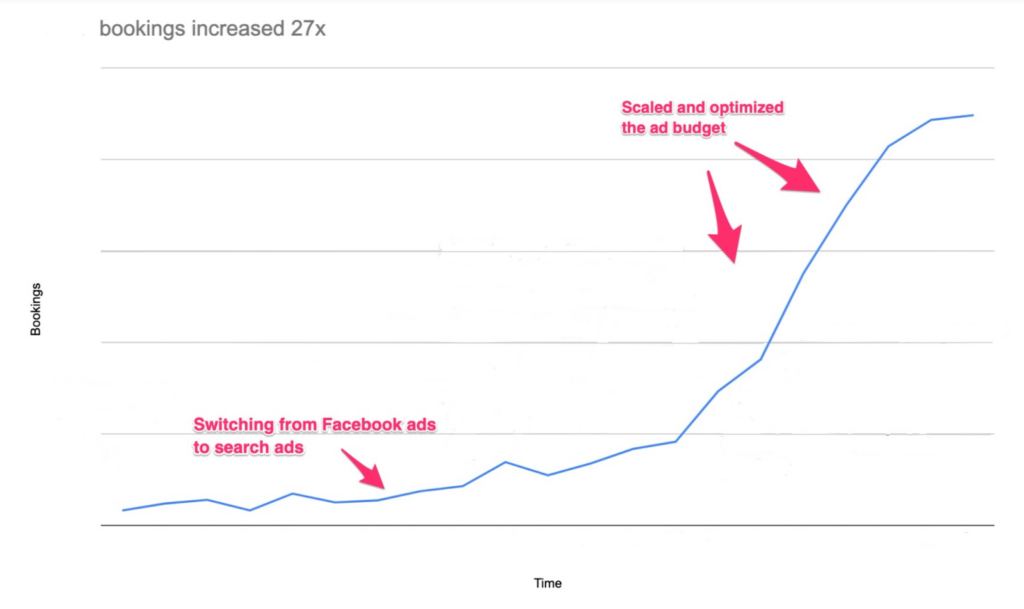I sunk into my chair mid-morning, coffee in hand. I knew what awaited me. The infamous spreadsheet, gloriously named “secret_sheet4000”, as if this was some top secret mission.
It wasn’t but the sheet was important nonetheless as it became the basis for the healthcare marketing case study you and I will look at today.
Since school, my friends and I have had an ongoing joke of naming files and folders with the most ridiculous, impossible-to-remember names. I guess that stuck.
Despite the filename, the sheet was packed to the brim with ad copy and performance metrics, in an attempt to get an overview of the many tests we were running.
Looking at this sheet on any normal-sized laptop was dreadful. It deserved to be displayed on a bigger screen, but there’s a charm to making things work in the early stages of a new business.
It’s not as if I could fit a second screen on my desk anyway.
In the best startup fashion, I shared the desk with the rest of the team. It was a mess with documents and old coffee cups lying around everywhere. Exactly what you’d expect from a new business finding its legs.
Table of Contents
Will this healthcare marketing case study be relevant for you?
Before we dive into the results of this healthcare marketing case study, I want to introduce you to the healthtech startup in question.
When this project took place, it offered primary care services at home for the elderly, children, and the like — think old-school family doctors doing house calls.
In their market, the services were primarily for an affluent niche of the population who wanted to avoid crowded clinics and hospitals.
One of their challenges in offering care twelve hours per day is that it gets costly to keep the physicians available before the brand is known well enough to drive bookings organically.
You’ll need to offer enough time slots to make the patients feel as if they can see a doctor nearly any time they want. If they have to wait too long, they’ll choose a competing service.
The problem: burning cash with little to show for it
This startup was spending thousands of dollars a month in operating costs and didn’t want it to go to waste.
They had seen success stories with digital ads and even tried running them in-house, but were stuck paying $48 per patient and discounting their services.
Not exactly what a founder (or marketer) dreams of.
That meant that they were stuck with both significant operational costs and expensive, ineffective ad campaigns. A lose-lose situation if there ever was one.
To add to that, they had heard horror stories of tech startups that depended on ads to grow before eventually dying a slow death as their markets became saturated and the ads stopped working.
The juicy results: a predictable way to gain new patients
Before
- Avg. $48 per new patient booking
- Deep discounts on care (leading to low operating margins)
- Uncertainty about where new patients will come from
After
- Avg. $19 per new patient booking (less than half the cost compared to before)
- Increased new patient bookings by 27x (to near-full patient capacity)
- No discounts on care (leading to better operating margins and patient quality)
- Built a predictable patient acquisition channel for the future
Within a few weeks of starting the project, we managed to get new patient bookings at just $9 apiece. It was an encouraging sign, but the startup had more capacity.
We ultimately ended up paying about double — $19 per new patient on average — to max out the capacity. That’s less than half of what they paid before and best of all, we didn’t need to offer deep discounts anymore which improved the operating margins significantly.
In my experience, discounts can be a tempting but “dangerous” thing to offer. It tends to produce short-term results but trains customers to hunt for discounts rather than staying loyal to the brand.
The new campaigns didn’t just lead to more affordable patient bookings, but at the same time increased the number of new patient appointments by 27x.
While the business still had to pay for the ads, this was the first sign of a viable, predictable patient acquisition channel—a critical step in getting the business off the ground in the early days.
The two strategies and tactics that made this healthcare marketing case study
In this article, I’m sharing two campaign ideas that worked well during this project.
If you’re interested in more juicy ideas and the secret sauce we use to drive new patients and leads with online marketing, use this box to express your interest.
As you’ll see in the graph below, we made a few significant changes on the journey to these results. The first one was moving the majority of the advertising budget away from the existing social media channels. That offered us a tiny but positive spike.
We used Google search ads for doctors to reach patients at the perfect time, and found healthcare keywords around the notion they might be looking for competing brands in their area or the best clinics near them.
The logic was that if patients were willing to look for care, they probably didn’t have a strong loyalty to a particular clinic. Alternatively, they might also not be aware that a certain brand they are interested in, doesn’t have availability or home services near them, thus they might be interested in an alternative.
As you can see in the bottom left of the graph, that produced the first signs that we were on the right track.

I’m sure you’re more interested in the second and much bigger increase on the graph, though. That came from optimizing the ads enough that it was worth increasing (scaling) the budget.
The 3 gladiator battles in Colosseum
There wasn’t a single magical ad or keyword, but rather an overall approach that made it happen. I like to look at these ads as gladiators in the Colosseum, fighting each other for the best performance with the loser getting eliminated.

To make it simple, let’s imagine three “battles”:
- Battle 1: targeting
- Battle 2: the offer
- Battle 3: perfecting the ad copy
During the first battle, the goal is figuring out how to best reach the right patients. During the second, it’s all about understanding what type of offer they best respond to, while in battle three, it’s time to perfect the details – usually the ad copy.
Within each battle, I like to pair different “gladiators” (ideas) up against each other and measure them based on the number of patients they drive through the door.
For example, in the first battle, I might run one targeting idea with competing brands in the neighborhood against another idea of the best clinic for X, to find out which one performs best. I’ll use nearly the same ad, landing page, and other creative elements to best isolate the different targeting ideas against each other.
If the budget allows for it, and I need results fast, I’ll sometimes run all the targeting ideas I have at once and go directly to testing different creative ads to see where they work best.
While running the campaigns in this case study, we noticed small “pockets” of well-converting traffic but with a ceiling of how many patients it could drive every day.
That is wonderful for a small clinic on a limited budget, but not nearly enough for a network of clinics looking for large scale.
As is the case with many campaigns, it’s not as simple as just throwing more money at the campaigns. The popular ad platforms have a tendency to happily accept our money but that doesn’t mean we get more bookings out on the other end.
To solve that, we had to build new creative sales funnels for less obvious keywords to convert them into appointment bookings as well.
By the nature of what those searchers were looking for, they didn’t convert as well and we had to trade a lower cost per booking for a higher patient volume.
A great deal overall as long as you keep tabs on the patient experience, so as not to trade a short-term boost in patients with a bad reputation long-term.
Takeaways
- In this healthcare marketing case study, we found that search ads converted well and ultimately traded a lower cost per patient booking for a higher volume of patients to find the perfect balance
- Using a simple framework to optimize the ad campaigns can help turn all the confusing elements and configurations into predictable performance